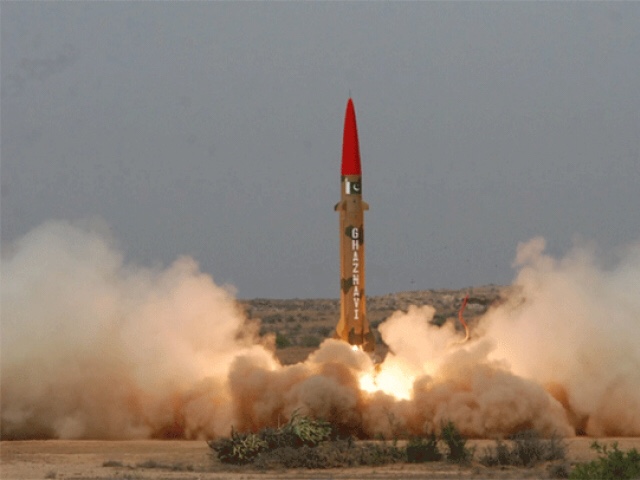 Nuclear war clouds hovering
Nuclear war clouds hoveringDr Zafar Nawaz Jaspal
THE Indian civil and military leadership’s irrational war-mongering could have disastrous consequences for the subcontinent in particular, and the South Asia in general. The flirtation with ‘nuclear bluff’ and ‘surgical strikes’ only thicken the nuclear war clouds hovering over the region. The Indian ruling elites misperception to strike Pakistan with impunity is an erroneous and perilous conclusion. The Indian military elite is deliberately increasing tension with Pakistan to convince the Indian parliamentarians that Indian Army requires more funds in the forthcoming defense budget. On September 6 2017, Indian Army Chief General Bipin Rawat indirectly demanded more funds for military modernization. He stated: “War is very much in the realm of reality.” He added, “believing there will no war – as some are akin to – affects the modernization of forces. Such thinking affects budgetary allocation.” Subsequently, the Indian army drastically increased fire on the Line of Control to conceal its failure in the Indian occupied Kashmir and also to qualify its demand for increasing Indian army budget.
Realizing that sooner budget session will start in New Delhi General Bipin Rawat once again attempted to draw the attention of his government towards the Army. On January 12, 2018, he stated: “We will call the (nuclear) bluff of Pakistan. If we will have to really confront the Pakistanis, and a task is given to us, we are not going to say we cannot cross the border because they have nuclear weapons. We will have to call their nuclear bluff.” Perhaps, it’s an appropriate tactic for securing finances for the modernization of the Army, but an absurd and destabilizing statement for the strategic stability in South Asia. The alarming reality is that General Bipin is failing to realise the repercussions of his misreading Pakistan’s nuclear weapon capability and too much confidence in India’s cold Start Doctrine. His jingoistic statement is a tantamount to an invitation for a nuclear war. Islamabad gave a befitting response. On January 13, 2018, Pakistani Foreign Minister Khawaja Asif cautioned: “Amounts to invitation for nuclear encounter. If that is what they desire, they are welcome to test our resolve. The general’s doubt would swiftly be removed, In Sha Allah [God willing].” ISPR spokesman warned that India must not remain in illusion: “Should they wish to test our resolve, they may try and see it for themselves. We have a credible nuclear capability, exclusively meant for threat from east. But we believe it’s a weapon of deterrence, not a choice.” These statements confirm that Pakistani armed forces are prepared to thwart any kind of the Indian armed forces military adventurism.
Since February 2000, the Indian strategic pundits have been contemplating to chalk out a military doctrine and modernize their ham-fisted armed forces to bleed Pakistan in a limited conventional war. The desire to acquire military ability and capability that could allow India to operate below Pakistan’s actual nuclear threshold(s) resulted in colossal spending on the modernization of the Indian armed forces. So that in a military operation the Indian armed forces could be able to give surprise and beat Pakistani border forces and capture territory within a limited time before the arrival of Pakistani main offensive and defensive formations. The critical examination of India and Pakistan’s conventional forces balance reveals that the conventional asymmetry between the nuclear-armed belligerent neighbors is not so much that it guarantees either side an outright victory in a limited war as well as total war. Nevertheless, India’s continuous increase in defense budget and mega military hardware purchases from the foreign defense contractors generates an impression that Indian armed forces might have advantage in war in the near future.
India has also been transforming its nuclear doctrine. It has shifted its nuclear posture from a ‘massive retaliation’ and ‘No-First-Use’ to one based on first-strike. Therefore, its nuclear posture is in a preemptive mode. The abandoning of no first-use and development of missiles defense shield incites Indians military elite to conduct surgical strikes. Indeed, these developments are perilous for the regional security. To conclude, it’s impossible for the Indians to alter the strategic equilibrium between India and Pakistan. It’s because, the latter is not ignorant of former’s military modernisation. Though Islamabad is not matching the Indian conventional military buildup, yet it is gradually advancing its nuclear arsenal. Hence, the Indians ‘nuclear bluff’ or ‘surgical strike’ approach only increases the probability of nuclear catastrophe in the region.
— The writer is Associate Professor, School of Politics and International Relations, Quaid-i-Azam University, Islamabad.
No comments:
Post a Comment